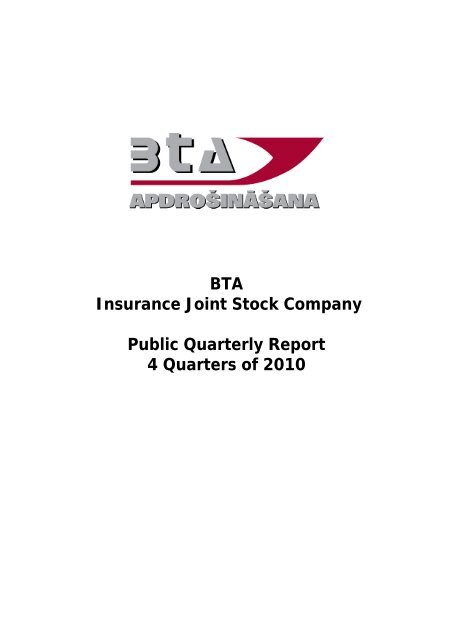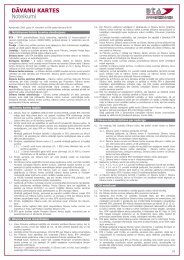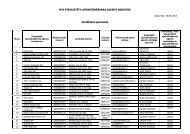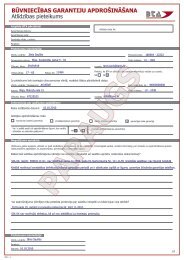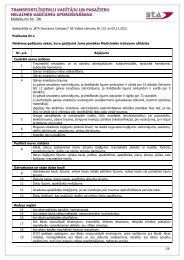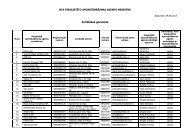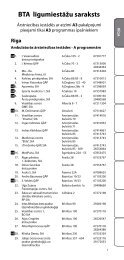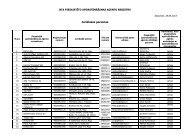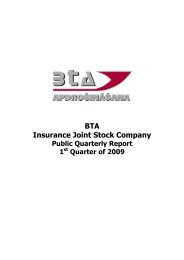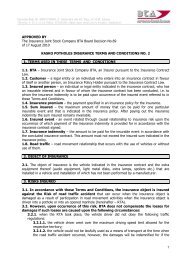BTA Insurance Joint Stock Company Public Quarterly Report 4 ...
BTA Insurance Joint Stock Company Public Quarterly Report 4 ...
BTA Insurance Joint Stock Company Public Quarterly Report 4 ...
You also want an ePaper? Increase the reach of your titles
YUMPU automatically turns print PDFs into web optimized ePapers that Google loves.
<strong>BTA</strong><br />
<strong>Insurance</strong> <strong>Joint</strong> <strong>Stock</strong> <strong>Company</strong><br />
<strong>Public</strong> <strong>Quarterly</strong> <strong>Report</strong><br />
4 Quarters of 2010
This <strong>Report</strong> is prepared in accordance with the 24 March 2006 Financial and Capital Market<br />
Commission Regulations No. 61 “Regulations on Preparation of <strong>Public</strong> <strong>Quarterly</strong> <strong>Report</strong>s of the<br />
Insurers”.<br />
The <strong>Report</strong> includes the summarized information on the <strong>Company</strong>’s activity over the 4 quarters<br />
of 2010. This information is comparable with the previous reporting periods<br />
Information on the <strong>Company</strong><br />
Name of the <strong>Company</strong><br />
Legal status<br />
Number, place and date of<br />
registration<br />
Address<br />
Members of the Board and their<br />
positions<br />
Members of the Council and their<br />
positions<br />
<strong>BTA</strong> AAS<br />
<strong>Insurance</strong> joint stock company<br />
40003159840, Riga, 1993<br />
Kr.Valdemāra 63, Riga<br />
Gints Dandzbergs – Chairman of the Board<br />
Janis Lucaus – Vice President<br />
Jelena Alfejeva – Vice President<br />
Agris Dambenieks – Chief Accountant<br />
Andrejs Skroderis – Director of the Risk Underwriting<br />
Department<br />
Pauls Dandzbergs – Chairman of the Council<br />
Andrejs Galanders – member of the Council<br />
Marts Dandzbergs – member of the Council<br />
<strong>Report</strong>ing Period 01.01.2010 - 31.12.2010<br />
Information on shareholders<br />
% of the<br />
Number share<br />
of shares capital<br />
TIA AS 9 578 9.58%<br />
Individuals – residents of the<br />
Republic of Latvia<br />
90 422 90.42%<br />
100 000 100%<br />
Nominal value of one share<br />
Subscribed share capital<br />
LVL 100.00<br />
LVL 10 000 000<br />
Paid-up share capital LVL 10 000 000<br />
Affiliated company<br />
<strong>BTA</strong> Draudimas UAB, Lithuania, 100% control,<br />
<strong>BTA</strong> Help OU, Estonia, 100% control<br />
2
Income Statement<br />
Item<br />
During the <strong>Report</strong>ing<br />
Period<br />
In the Respective Period<br />
of the Previous <strong>Report</strong>ing<br />
Year<br />
Earned premiums 45 334 536 53 824 516<br />
Other technical income, net 34 359 84 554<br />
Incurred claims, net (26 812 372) (34 268 438)<br />
Changes in other technical reserves - -<br />
Gratuities, net - -<br />
Net operating expenses (16 038 838) (15 882 551)<br />
Other technical expenses, net (214 911) (727 863)<br />
Changes in equalization reserves (9 555) -<br />
Investment management expenses/income and<br />
commission payments<br />
(51 777) (87 057)<br />
Net interest income and dividend income 1 824 298 2 239 149<br />
Net realized profit/loss from financial assets<br />
and financial liabilities, which are not<br />
- -<br />
recognized at fair value through profit and loss<br />
Net profit/loss from financial assets and<br />
financial liabilities held for trading<br />
- -<br />
Net profit/loss from the financial assets and<br />
financial liabilities classified at fair value<br />
1 358 598 633 518<br />
through profit and loss<br />
Revaluation result of foreign currencies 171 657 (91 711)<br />
Profit/loss from derecognition of tangible<br />
assets, investments in buildings for ensuring<br />
own activities, investments in property and<br />
- -<br />
intangible assets<br />
Depreciation (410 479) (426 497)<br />
Impairment losses (429 443) (359 911)<br />
Increase/decrease in value of investment in<br />
property<br />
(283 640) (712 396)<br />
Other income/(expenses) that are not<br />
recognized in other items, net<br />
(127 547) (193 219)<br />
Profit/loss of the reporting period before<br />
taxes<br />
4 344 886 4 032 094<br />
3
Indicators by Type of <strong>Insurance</strong><br />
Type of <strong>Insurance</strong><br />
Gross<br />
Premiums<br />
Written<br />
Net<br />
Premiums<br />
Written<br />
Gross<br />
<strong>Insurance</strong><br />
Claims Paid<br />
Net<br />
<strong>Insurance</strong><br />
Claims Paid<br />
Net<br />
operating<br />
expenses<br />
Accident insurance 596 259 555 222 253 723 241 774 160 809<br />
Health <strong>Insurance</strong> 5 646 696 5 646 696 5 485 353 5 485 353 2 008 203<br />
Motor vehicle insurance (other<br />
than railway)<br />
11 804 939 11 727 702 7 524 074 7 505 501 4 493 070<br />
Railway transport insurance 105 641 95 288 2 797 2 797 28 778<br />
Aircraft insurance 73 125 12 901 53 212 8 688 12 442<br />
Vessel insurance 166 255 17 687 231 835 31 131 4 853<br />
Cargo insurance 427 423 291 083 418 507 194 206 135 644<br />
Property insurance against fire<br />
and natural disaster damages<br />
5 838 703 4 781 133 1 784 615 1 582 209 2 210 926<br />
Property insurance against other<br />
risks<br />
800 929 735 663 667 855 667 855 276 467<br />
Civil liability insurance of motor<br />
vehicle owners<br />
496 516 103 859 0 0 106 648<br />
Compulsory civil liability insurance<br />
of motor vehicle owners*<br />
17 778 246 16 860 565 7 687 627 7 687 384 4 885 527<br />
Civil liability insurance of aircraft<br />
owners<br />
139 477 17 468 5 196 446 16 197<br />
Civil liability insurance of vessel<br />
owners<br />
34 110 3 411 0 0 4 020<br />
General civil liability insurance<br />
1 232 322 808 218 122 232 120 973 303 436<br />
Loan insurance 233 659 103 794 88 784 29 122 43 792<br />
Guarantee insurance 815 193 247 481 130 837 45 821 184 310<br />
<strong>Insurance</strong> of various financial<br />
losses<br />
1 205 517 912 742 25 069 15 861 267 306<br />
<strong>Insurance</strong> of legal expenses 120 120 0 0 27<br />
Assistance insurance 1 660 491 1 624 081 290 691 272 354 896 384<br />
Total 49 055 621 44 545 114 24 772 407 23 891 475 16 038 838<br />
* including OCTA compulsory deductions amounting to LVL 326 461<br />
4
Type of <strong>Insurance</strong><br />
Loss Indicator<br />
(Accepted<br />
Compensation Claims,<br />
Net/Earned Premiums,<br />
Net)<br />
Expense Indicator ((Net<br />
Operating Expenses +<br />
Other Technical<br />
Expenses, Net – Other<br />
Technical Income, Net)/<br />
Earned Premiums, Net)<br />
Combined Indicator<br />
(Loss Indicator +<br />
Expense Indicator)<br />
Accident insurance 64.18% 35.08% 99.26%<br />
Health insurance 48.35% 24.60% 72.95%<br />
Motor vehicle insurance (other<br />
than railway)<br />
56.77% 37.05% 93.83%<br />
Railway transport insurance 3.45% 29.80% 33.25%<br />
Aircraft insurance 33.34% 95.97% 129.30%<br />
Vessel insurance 79.39% 13.06% 92.46%<br />
Cargo insurance 93.25% 41.76% 135.01%<br />
Property insurance against fire<br />
and natural disaster damages<br />
48.50% 47.92% 96.41%<br />
Property insurance against other<br />
risks<br />
15.81% 37.12% 52.93%<br />
Civil liability insurance of motor<br />
vehicle owners<br />
178.06% 62.18% 240.24%<br />
Compulsory civil liability insurance<br />
of motor vehicle owners<br />
81.43% 33.82% 115.25%<br />
Civil liability insurance of aircraft<br />
owners<br />
-209.32% 114.79% -94.54%<br />
Civil liability insurance of vessel<br />
owners<br />
51.16% 283.13% 334.30%<br />
General civil liability insurance<br />
11.00% 33.95% 44.95%<br />
Loan insurance 5.19% 17.68% 22.87%<br />
Guarantee insurance 31.66% 67.49% 99.14%<br />
<strong>Insurance</strong> of various financial<br />
losses<br />
14.49% 40.55% 55.05%<br />
<strong>Insurance</strong> of legal expenses 1538.46% 41.52% 1579.98%<br />
Assistance insurance 21.79% 57.93% 79.71%<br />
Total 59.14% 35.78% 94.92%<br />
5
Balance Sheet<br />
Item<br />
<strong>Report</strong>ing Period<br />
Previous <strong>Report</strong>ing<br />
Year<br />
Signed but not paid-up share capital - 244 634<br />
Tangible assets 525 226 396 906<br />
Investments in land lots and buildings 5 469 968 5 982 280<br />
Intangible assets 72 894 85 567<br />
Investments in share capital of related companies 4 243 424 3 334 392<br />
Investments in share capital of associated companies - 245 981<br />
Financial assets held for trading - -<br />
Classified as financial assets at fair value through profit<br />
and loss<br />
25 724 421 24 233 205<br />
Financial assets available-for-sale 411 878 185 740<br />
Held-to-maturity investments 15 507 503 13 084 555<br />
Loans granted and debtor debts 13 631 203 15 158 233<br />
Accrued income and deferred expenses 3 428 911 2 391 167<br />
Tax assets - -<br />
Reinsurance contracts 7 797 480 5 092 335<br />
Cash on hand and claims on demand on credit<br />
institutions<br />
1 110 622 546 743<br />
Total assets 77 923 530 70 981 738<br />
Capital and reserves 26 243 270 22 899 997<br />
<strong>Insurance</strong> liabilities 47 914 282 43 068 109<br />
Subordinated liabilities - -<br />
Classified as financial liabilities at fair value through<br />
profit and loss<br />
- -<br />
Financial liabilities at amortised cost 2 261 806 3 532 453<br />
Provisions 991 837 961 699<br />
Tax liabilities 275 992 241 618<br />
Accrued expenses and deferred income 236 343 277 862<br />
Total liabilities 51 680 260 48 081 740<br />
Total capital and reserves, and liabilities 77 923 530 70 981 738<br />
6
Risks and Risk Management<br />
The business of insurance represents the transfer of risk from the insurance policy<br />
holder to the insurer and management of this risk. The largest insurance risks are<br />
formed by the insurer accepting the insured risk, assessing it, choosing the<br />
reinsurance coverage and fulfilling obligations as regards concluded insurance<br />
contracts. The Insurer is also exposed to the investment risk, when the <strong>Company</strong> has<br />
to cover technical reserves with assets invested in various financial instruments,<br />
which includes the market risk, credit risk, liquidity risk and operational risk.<br />
The Management of the <strong>Company</strong> has identified the risks and developed the<br />
management of these risks. Risk management is carried out in accordance with<br />
decisions of the <strong>Company</strong>’s Board.<br />
The Management of the <strong>Company</strong> has divided all risks into the following major<br />
groups:<br />
- <strong>Insurance</strong> risks;<br />
- Financial risks;<br />
- Operational risks.<br />
Each of these groups is divided into subgroups, which identify the risks that might<br />
affect any of the operating directions. Each risk has an action plan elaborated for it<br />
to be implemented to minimize and avoid the possibility of the risk occurring.<br />
<strong>Insurance</strong> Risks and Risk Management<br />
<strong>Insurance</strong> risk is the most significant risk faced by the <strong>Company</strong> in its daily activities.<br />
(a) Underwriting Strategy<br />
The <strong>Company</strong>’s underwriting strategy seeks diversity to ensure a balanced risk<br />
portfolio and is based on a large portfolio of similar risks held over a number of years<br />
and that changes the total risk effect.<br />
The underwriting strategy is included in the annual business plan, which describes<br />
the types of insurance, where the premiums are written, as well as branches and<br />
sectors in which the <strong>Company</strong> is prepared to undertake the risk. This strategy is<br />
adapted to individual risk underwriters using a detailed risk underwriting authority<br />
system that sets out the limits for individual risk underwriters by the type of<br />
insurance, business class and sector to develop a corresponding risk profile within<br />
the scope of the insurance portfolio. A non-life insurance contract may be concluded<br />
for a period of time up to five years; however, they are usually annual and the risk<br />
underwriters are entitled to refuse contract prolongation or renewal, or to change<br />
terms and conditions of the contract upon the prolongation (renewal).<br />
The calculation of insurance product tariffs and prices reflects current market<br />
situation and includes potential income necessary for the adjustment of future results<br />
in order to significantly hedge the financial risk.<br />
The Management of the <strong>Company</strong> monitors compliance with the underwriting<br />
authorities on a regular basis. The Management of the <strong>Company</strong> examines<br />
transactions that require particular approval.<br />
(b) Basic Product Features<br />
Terms and conditions of the insurance contracts that have significant effect on the<br />
amount, term and transparency of the future cash flow amounts from insurance<br />
contracts are described below. Evaluation of the basic products of the <strong>Company</strong> and<br />
the way risks are managed is also provided.<br />
7
CASCO<br />
This type of insurance indemnifies for the losses incurred due to damage or loss of a<br />
vehicle. Several individual types of insurance coverage are offered that are related to<br />
the insured vehicle. CASCO insurance rates are determined by applying the bonusmalus<br />
system, according to which the insurance premium is reduced if there were no<br />
losses and increased if losses have been incurred. The sums insured very rarely<br />
exceed LVL 50 thousand. The major losses occur upon theft or destruction of<br />
vehicles.<br />
Civil Liability <strong>Insurance</strong> of Motor Vehicle Owners (OCTA)<br />
It is a compulsory type of insurance, the terms and conditions and indemnification of<br />
which are governed by the Law on Compulsory Civil Liability <strong>Insurance</strong> of Owners of<br />
Motor Vehicles and other regulatory enactments. OCTA insurance rates are<br />
determined by applying the bonus-malus system, according to which the insurance<br />
premium is reduced if there were no losses and increased if losses have been<br />
incurred.<br />
OCTA insurance covers injury and property damage claims in Latvia, as well as<br />
claims incurred abroad regarding vehicles insured in the Green Card system.<br />
OCTA indemnifies for losses caused to the property and pays indemnities to people<br />
in the event of injuries, mostly for medical treatment costs and temporary disability.<br />
However, long-term indemnities are also possible, such as pensions and permanent<br />
disability benefits, which could be paid out over the long term and which could be<br />
paid out as annuities.<br />
Although previous experience shows that the claims are being submitted immediately<br />
and they can be settled instantly, the situation may change and the claims arising<br />
from OCTA are classified as long-tail insurance, where determination of the final<br />
payment of the claim requires more time.<br />
The most significant risks related to this product are underwriting risk, competition<br />
risk and claim experience risk. The premium calculation based on the risk of these<br />
policies is going to be a prejudiced therefore risky procedure. The insurance risk<br />
management is mainly carried out by determining a reasonable price policy, type of<br />
products, risk selection, corresponding investment strategy, rating and reinsurance.<br />
The <strong>Company</strong> monitors changes in the overall economic and business environment,<br />
in which it operates, and takes actions in accordance with the changes.<br />
Health <strong>Insurance</strong><br />
The health insurance product is offered to companies that purchase health insurance<br />
for their employees. Health insurance covers such expenses as doctor visits, hospital<br />
expenses and acquisition of medicinal products.<br />
The <strong>Company</strong> monitors and takes into account changes in medical service prices,<br />
monitors the amount of claims for each employer and makes respective changes in<br />
prices when renewing policies.<br />
Property <strong>Insurance</strong><br />
Property insurance covers property-related risks, such as fire, pipe leakage,<br />
explosion, burglary and robbery, as well as storm risk. Civil liability insurance can be<br />
purchased for the property insurance.<br />
Business interruption insurance covers foregone income and fixed costs, if the loss is<br />
caused by the risk covered in accordance with the property insurance policy. When<br />
selling these insurance policies, the reliability of customers and transparency of<br />
financial statements play a major role.<br />
The most frequent risks as regards private property are pipe leakage and fire. The<br />
greatest losses are most frequently caused by fire.<br />
8
In general, property insurance claims are submitted immediately and they can be<br />
settled without any delay. Property insurance is classified as short-tale instead of<br />
long-tail, where determination of the final payment of the claim requires more time.<br />
The most significant risks related to this product are underwriting risk, competition<br />
risk and claim experience risk.<br />
The underwriting risk is the risk that the <strong>Company</strong> has not collected respective<br />
premiums for the insured property. A large amount of property with the similar risk<br />
portfolio is anticipated in housing insurance. However, the situation may be different<br />
in commercial property insurance. Most of the commercial property insurance offers<br />
include both location and type of business, as well as overall security measures<br />
taken. The premium calculation based on the risk of these policies is going to be a<br />
prejudiced therefore risky procedure.<br />
Property insurance is exposed to the risk that an insured person would submit<br />
fictitious or invalid claims or will indicate a larger amount of loss. It can be mainly<br />
explained by the effect of the economic situation on the profitability of the property<br />
insurance sector. The insurance risk management is mainly carried out by applying<br />
price determination mechanisms, independent property assessment in accordance<br />
with the international standards, product development, risk selection and<br />
reinsurance. The <strong>Company</strong> monitors changes in the overall economic and business<br />
environment, in which it operates, and takes actions in accordance with the changes.<br />
(c) <strong>Insurance</strong> Risk Concentration<br />
In the insurance procedure risk concentration may occur if some event or the<br />
succession of events can affect the amount of <strong>Company</strong>’s liabilities. Risk<br />
concentration may occur in regard to one insurance contract or several related<br />
contracts and is related to circumstances that may result in significant insurance<br />
liabilities.<br />
The Management of the <strong>Company</strong> is aware of the insurance risk concentration. Risk<br />
concentration may occur as a result of different coincidences and regularities. Most<br />
often, risk concentration is observed in the type of insurance in which individuals are<br />
insured, i.e., assistance or accident insurance, when a group of persons suffers in an<br />
accident and all these people are insured by the <strong>Company</strong>. In property insurance,<br />
risk concentration might occur if one small, densely populated area experiences any<br />
exposures (e.g. fire) that may easily spread from one object to another and which<br />
cannot be prevented.<br />
Additionally, the Management realizes that risk concentration is possible in one<br />
company, or an overall economic sector, for which several risks are insured. When<br />
insuring such risks, a mandatory precondition is to assess the financial standing and<br />
capacity of the company, as well as to determine the amount of financial obligations<br />
that can arise, are already undertaken by the <strong>Company</strong> and that can be afforded in<br />
the future. Economic development trends and risks that might affect a respective<br />
sector are studied when assessing the financial risks.<br />
To minimize the losses that could arise in the event of risk concentration, the<br />
<strong>Company</strong> uses reinsurance – reinsuring both proportionally, and non-proportionally.<br />
When making reinsurance the <strong>Company</strong>’s share in the risk is determined both for one<br />
object, and one event, in which losses may be caused simultaneously for several<br />
objects. Such risks are reinsured in almost all types of insurance. The reinsurance<br />
policy applied by the <strong>Company</strong> is approved by the Board of the <strong>Company</strong>.<br />
The <strong>Company</strong> applies two most significant methods in the management of these<br />
risks. First, the risk is being underwritten by applying the corresponding underwriting<br />
policy. Risk underwriters are allowed to underwrite risks only when the expected<br />
profit is proportional to the amount of assumed risk. Secondly, reinsurance is being<br />
used in risk management. The <strong>Company</strong> acquires the reinsuring coverage in various<br />
9
types of liability and property insurance. The <strong>Company</strong> assess costs and benefits<br />
related to the reinsurance programme on a regular basis.<br />
The <strong>Company</strong> determines the total risks it is ready to assume in regard to risk<br />
concentration. The <strong>Company</strong> monitors these risks both when underwriting risks, and<br />
monthly by verifying reports representing the main risk concentration the <strong>Company</strong> is<br />
exposed to. The <strong>Company</strong> uses several simulation instruments in order to monitor<br />
the risks and assess the efficiency of reinsurance programmes and net risks the<br />
<strong>Company</strong> is exposed to. By applying these models, several additional stress and<br />
scenario tests are being used over a year.<br />
(d) Catastrophes<br />
The <strong>Company</strong>’s Management is aware of the probability of catastrophe risks. Under<br />
our geographical conditions, these risks are mostly related to metrological<br />
phenomena: storms, floods, natural disasters (hail, snow, icing, etc.). Large fires and<br />
earthquakes are unlikely, but the possibility exists. The most characteristic<br />
catastrophes are floods and storms. Reinsurance is used in order to minimize the<br />
impact of catastrophe risk on the <strong>Company</strong>. Reinsurance is both proportional, and<br />
non-proportional. Facultative insurance is additionally acquired for large risks. The<br />
<strong>Company</strong> has developed a methodology to determine its risk share. It depends on<br />
many factors and historical statistical information in each group of products.<br />
According to the Management, the measures taken to minimize the impact of<br />
catastrophe risk on the <strong>Company</strong> are sufficient.<br />
(e) <strong>Insurance</strong> Risk Management<br />
In order to minimize the insurance risk, the <strong>Company</strong> has developed different control<br />
and management mechanisms. Terms and conditions binding on the <strong>Company</strong> and<br />
the customers are being developed in all types of insurance. When determining the<br />
total risk and the amount of the risk assumed, the set methodology developed for<br />
each type of insurance must be complied with. The <strong>Company</strong> has a Risk Underwriting<br />
Division, the staff of which is responsible for the development of particular types of<br />
insurance, insurance terms and conditions, as well as risk assessment methods. In<br />
addition, there are limits set up to which certain employees are entitled to take<br />
decisions regarding risk underwriting. When determining these limits, the hierarchy<br />
of employees is taken into consideration, i.e., the higher position, the higher the risk,<br />
which may be underwritten.<br />
Although certain mechanisms are introduced and risks are managed, the <strong>Company</strong>’s<br />
Management realizes that there is a risk that the insurance risk assessment may not<br />
be of high quality and incorrect decisions may be taken. In addition, there is a risk<br />
that insurance indemnities will be set in a way that does not correspond to the losses<br />
caused, or the insurance claim will take too long to administer.<br />
In order to minimize these risks, the <strong>Company</strong> has developed and uses a quality<br />
management system that describes all procedures and provisions made by the<br />
<strong>Company</strong> during the course of insurance administration and claim adjustment. The<br />
quality management system prescribes when and under what circumstances certain<br />
procedures are to be complied with. Quality assessment may be carried out in any<br />
process. It can also be determined whether this process is carried out in compliance<br />
with the <strong>Company</strong>’s interest and the planned processes. The Quality Management<br />
Department is responsible for evaluating the process. This Department also regularly<br />
provides the <strong>Company</strong>’s Management with information on management of the<br />
processes in the <strong>Company</strong>. Based on this evaluation, the Management may take<br />
respective decisions in order to minimize the risk related to the insurance processes.<br />
10
(f) Liability Conformity Test<br />
The <strong>Company</strong> has assessed its insurance liabilities presented in the financial<br />
statement as at 31 December 2009 applying the liability conformity test (“LAT”).<br />
The liability conformity test is conducted on each financial statement date in a<br />
breakdown by types of insurance in order to evaluate whether the recognized<br />
insurance liabilities less deferred customer attraction expenses are appropriate taking<br />
into consideration future cash flow from insurance contract under current<br />
calculations. If the evaluation shows that liabilities are not appropriate taking into<br />
account future cash flow, the deficiency is recognized in the Income Statement. The<br />
expected cash flow related to insurance claims and expenses is calculated using<br />
historical data adjusted by significant particular losses, the re-occurrence of which is<br />
not expected. The liability conformity test is conducted in a breakdown by types of<br />
insurance, which include insurance contracts with similar types of risks.<br />
Financial Risks and Risk Management<br />
The <strong>Company</strong> is exposed to financial risks if it makes transactions with financial<br />
instruments. Financial risks include the market risk, which, in turn, includes price,<br />
interest rate and currency risks, the credit risk and the liquidity risk. The description<br />
and summary of financial risks regarding the methods applied by the <strong>Company</strong> in the<br />
management of these risks are provided below. These risks are caused by daily<br />
business activities of the <strong>Company</strong>.<br />
Financial assets and financial liabilities of the <strong>Company</strong>, including investments, bank<br />
deposits, loans, insurance receivables and reinsurance assets, are exposed to the<br />
following financial risks:<br />
• Market risk: negative changes in the market situation may affect the insurer’s<br />
assets and/or liabilities, investments may depreciate and return of assets may<br />
decrease; The Market risk includes interest rate risk, capital price risk and<br />
currency risk;<br />
• Credit risk: failure of the business partner to fulfil contractual obligations may<br />
cause financial losses to the <strong>Company</strong>;<br />
• Liquidity risk: under certain adverse conditions, the insurer may be forced to sell<br />
assets at a lower price than the fair value thereof to fulfil the obligations.<br />
Market Risk<br />
Financial instruments and items are exposed to the market risk, which is the risk that<br />
changes in the market situation in the future may decrease or increase the value of<br />
the financial instrument. The <strong>Company</strong> is exposed to a potential investment risk by<br />
incurring losses from financial assets, financial liabilities, reinsurance and insurance<br />
contractual obligations caused by changes in interest rates, exchange rates and<br />
prices of capital instruments.<br />
In order to hedge the investment risk, investments are made in different financial<br />
instruments. Requirements of the Law on <strong>Insurance</strong> Companies and Supervision<br />
Thereof are complied with when selecting financial instruments.<br />
When performing investment activity, employees of the AAS <strong>BTA</strong> Financial<br />
Department comply with the improved investment procedures, which regulate many<br />
issues related to the control and hedging of the investment risk.<br />
The investment risk hedging is carried out in two ways – first, by diversifying the<br />
investment portfolio and second, by analysing the asset before the purchase thereof<br />
and regularly obtaining available information on it later.<br />
The <strong>Company</strong> manages the market risk by mainly investing in markets and<br />
investments with high ratings.<br />
11
Currency Risk<br />
Currency risk: adverse changes in currency exchange rates may cause losses to the<br />
<strong>Company</strong>.<br />
Some of the insurance risks are denominated in foreign currencies. The <strong>Company</strong>’s<br />
policy is to hedge the currency risk regarding known and expected transactions in<br />
foreign currencies. The <strong>Company</strong> tries to minimize the currency risk by making<br />
investments in respective currencies. Local currencies on the <strong>Company</strong>’s operation<br />
markets in Latvia, Estonia and Lithuania are pegged to EUR, which decreases the<br />
probability of the currency risk. Pegging may change upon changes in<br />
macroeconomic policy. Profit or loss is mainly sensitive only to changes in USD<br />
exchange rate; however, this effect is minimal. The <strong>Company</strong> is not involved in any<br />
speculative transactions that could increase the currency risk.<br />
The <strong>Company</strong> is gradually increasing the proportion of EUR investments. In<br />
compliance with the above-mentioned principle, at the end of 2009 investments<br />
nominated in EUR covered one third of the technical reserves nominated in LVL.<br />
Even though this policy affects return on investment, it will be also applied in 2010,<br />
in order to limit the potential impact that could occur due to the government<br />
introducing changes in the currency policy.<br />
Price Risk<br />
The price risk is the risk when changes in market prices may result in changes in the<br />
value of the financial instrument. Such changes may be caused by both the factors<br />
that only apply to a respective instrument and the factors that have effect on all<br />
financial instruments on the market. The price risk occurs when the <strong>Company</strong><br />
assumes long or short position of the financial instruments.<br />
Interest Rate Risk<br />
Implementation of the interest rate risk hedging measures is carried out in the<br />
<strong>Company</strong> by assessing the impact of the interest rate risk on the <strong>Company</strong>’s financial<br />
indicators. The <strong>Company</strong> has no significant liabilities, for which interest is to be paid,<br />
and the significant part of interest bearing assets are with the fixed interest rate.<br />
The <strong>Company</strong> is not exposed to a significant interest rate risk or the effect of<br />
fluctuations in interest rates, which arise from different maturities of the <strong>Company</strong>’s<br />
interest bearing assets and liabilities or interest term structure profile.<br />
Liquidity Risk<br />
In accordance with the approved investment procedure, employees of the AAS <strong>BTA</strong><br />
Financial Department must ensure that at least 30 per cent of the assets required to<br />
cover technical reserves are placed in high-liquidity investments.<br />
The following assets are considered high-liquidity investments:<br />
1) claims on the demand to credit institutions;<br />
2) other claims to solvent credit institutions (term deposits, etc.), the remaining<br />
maturity of which does not exceed 30 days and deposits with another term, if<br />
the agreement provides for an early withdrawal of money (deducting the<br />
penalty for early withdrawal of the deposit, if such is provided for);<br />
3) investments in securities with a constant, unrestricted market, i.e., they can<br />
be sold in a short time without considerable losses or they can be used as<br />
collateral to receive a loan.<br />
Credit Risk<br />
The <strong>Company</strong> is exposed to credit risk, which is the risk that a transaction party will<br />
be unable to pay the amounts of the obligations in full and in due time. The<br />
<strong>Company</strong> structures the levels of the assumed credit risk by determining limits as<br />
12
egards the amount of the assumed risk to one issuer of securities, a debtor, a<br />
borrower or the groups of the above-mentioned. Such risks are monitored on a<br />
regular basis.<br />
Credit risk occurs as regards direct insurance debtors and reinsurance debtors, and it<br />
is the risk that the business party will fail to fulfil its payment obligations.<br />
<strong>Insurance</strong> Receivable<br />
The Management monitors direct insurance receivables on a regular basis and<br />
cancels the policies if the insurance policy holder is notified in due manner, but the<br />
respective amount is not paid.<br />
Reinsurance<br />
The <strong>Company</strong> reinsures part of the underwritten risks in order to control its loss risk<br />
and protect capital resources. The <strong>Company</strong> has acquired a facultative Excess-of-<br />
Loss (XL) reinsurance in order to minimize net risks and not to exceed the actual<br />
solvency margin. The <strong>Company</strong> has also acquired reinsurance contracts in main<br />
types of insurance, which protect the <strong>Company</strong> from any common losses that may<br />
arise from several claims of the same event.<br />
As of 2008 <strong>BTA</strong> has made changes in its reinsurance policy making it even more<br />
conservative – now reinsurers are being attracted not only in the insurance of large<br />
risks, but an additional protection for the atypical accumulation of daily and<br />
comparatively insignificant risks is also being acquired. In particular types of<br />
insurance (CASCO, Railway, Cargo, Equipment) XL treaty is replaced with the Priority<br />
Aggregate XL treaty.<br />
The assigned reinsurance includes the credit risks and such recoverable reinsurance<br />
amounts are recognized by deducting the known insolvency cases and unrecoverable<br />
amounts. The <strong>Company</strong> monitors the financial standing of reinsurance on a regular<br />
basis and periodically verifies reinsurance contracts.<br />
Reinsurance is carried out with world-renowned reinsurance companies with<br />
excellent reputation.<br />
When carrying out reinsurance, the <strong>Company</strong> complies with the condition that the<br />
rating of reinsurance companies may not be lower than the Standard & Poor’s “BBB-”<br />
rating (or a similar assessment from another international rating agency). Almost all<br />
reinsurance is carried out with reinsurance companies whose rating is not lower than<br />
the Standard & Poor’s “A” rating.<br />
Reinsurance companies cover their liabilities within a period of 30 days. Reinsurance<br />
contracts also provide for the events when the reinsurance claim is to be paid<br />
immediately upon the insurance indemnity exceeding a certain amount. In 2009 and<br />
2008 there were no events when a reinsurance company would fail to fulfil its<br />
obligations towards the <strong>Company</strong>.<br />
Operational Risks and Risk Management<br />
The <strong>Company</strong> has established that a customer should receive high quality services.<br />
The <strong>Company</strong> has defined representation of the <strong>Company</strong> by qualified and<br />
competent employees as the most significant risk for provision of these services. In<br />
order to attract and keep medium and top level qualified employees, the <strong>Company</strong><br />
has introduced a competitive remuneration and motivation system, thus achieving<br />
low employee turnover in top and medium management. There is also a low<br />
employee turnover in the level of experts (88%) and the lowest level of experts<br />
(73%). The <strong>Company</strong> has established a training centre that concentrates on<br />
increasing employee qualifications. And information base has also been established<br />
and is accessible for daily work.<br />
13
According to the Management, the risk that any of the employees could intentionally<br />
or unintentionally influence the technical result of the type of insurance, by fixing<br />
unreasonably low prices or granting unreasonably high discounts, is limited to the<br />
minimum. When fixing the prices, the methodology must be strictly complied with;<br />
however, if deviations related to the market situation are required, such deviations<br />
must be mandatorily agreed upon with the top management. The discount policy is<br />
set by the Board of the <strong>Company</strong>. Deviations from this policy are not permitted.<br />
Information systems (IS) play a significant role in ensuring the efficiency of these<br />
<strong>Company</strong> activities. The Management of the <strong>Company</strong> pays great attention to ensure<br />
that these systems can work and comply with modern requirements. The <strong>Company</strong><br />
has an IT Department, the task of which is to ensure and maintain a safe and stable<br />
information system environment in the <strong>Company</strong>. The activities of this Department<br />
are regulated by IS security regulations, which are elaborated in accordance with the<br />
requirements of regulatory enactments. IS systems must ensure constant<br />
performance and meet the requirements of employees and customers. No deviations<br />
from the performance standards are permitted and compliance with them must be<br />
ensured 24 hours a day. A wait time is determined if necessary and is then required<br />
to restore performance if there have been damages to equipment or information<br />
resources. This time may not exceed 12 hours.<br />
Most Significant Cooperation Partners:<br />
Reinsurers<br />
Reinsurer Reinsurer’s Rating Rating Agency<br />
Place (Country) of<br />
Registration of the Insurer<br />
SWISS RE EUROPE AA- Standard & Poor’s Germany<br />
MUNICH RE AA- Standard & Poor’s Germany<br />
ATRADIUS RE AAA Standard & Poor’s Germany<br />
HANNOVER RE AA- Standard & Poor’s Germany<br />
<strong>Insurance</strong> and Reinsurance Brokerage Companies<br />
Brokerage <strong>Company</strong><br />
Service<br />
Place (Country) of<br />
Registration<br />
MAI Reinsurance Brokeris SIA <strong>Insurance</strong>/reinsurance mediation Latvia<br />
AON Re Reinsurance mediation Germany<br />
Operational Strategy and Objectives<br />
The <strong>BTA</strong> operational strategy and objectives aim to make the <strong>Company</strong> the leading insurance<br />
company in the Baltic market – a dynamic and professional company that satisfies the desires<br />
of its customers to receive high quality insurance products in any manner and at any place<br />
convenient to the customer. In order for <strong>BTA</strong> to become more available to current and<br />
potential customers, we continue to open branches abroad as well as in Latvia. The<br />
main tool <strong>BTA</strong> uses to achieve its set objectives is an individual approach toward each<br />
customer – in each particular situation <strong>BTA</strong> employees offer the best insurance<br />
solution to each customer. The entire <strong>Company</strong> has adopted high customer service<br />
standards that are applicable to each and every employee.<br />
14
Structural Units and Branches of the <strong>Company</strong><br />
Customer service locations that offer <strong>BTA</strong> insurance services.<br />
Regional centres, customer service centres and sales points in Latvia:<br />
http://www.bta.lv/lat/company/contacts/offices/policy/riga/<br />
Foreign branch in Estonia:<br />
http://www.bta-kindlustus.ee/<br />
Related company in Lithuania:<br />
http://www.bta.lt/<br />
15


